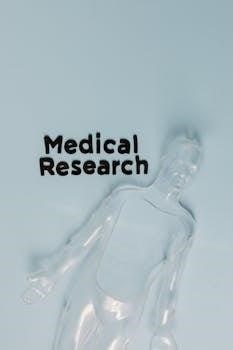exploring biology in the laboratory 3rd edition pdf
Category : PDF
Exploring Biology in the Laboratory 3rd Edition PDF⁚ A Comprehensive Guide
Exploring Biology in the Laboratory‚ 3rd Edition‚ is a comprehensive manual for introductory biology courses. It offers in-depth experiments for studying animal physiology and anatomy‚ including mammalian respiratory physiology. It’s a valuable resource that can be customized by instructors.
Overview of Exploring Biology in the Laboratory 3rd Edition
Exploring Biology in the Laboratory‚ 3rd Edition‚ presents a thorough and customizable lab manual suitable for both biology majors and non-majors. This edition provides a wide array of experiments covering general biology topics‚ ensuring students grasp the unity of living things and evolutionary forces. The manual is designed to minimize the need for external resources.
The 3rd edition features experiments that explore diversity and fundamental concepts like the scientific method‚ microscopy‚ acids‚ bases‚ organic molecules‚ and cellular composition. It is structured to serve as an excellent resource for introductory biology students‚ offering a streamlined set of clearly written activities.
Instructors can tailor the content to fit their specific course needs and lab safety requirements‚ ensuring that the material is directly relevant to their students; The full-color presentation enhances the learning experience‚ making complex topics more accessible. Key areas include animal physiology‚ anatomy‚ and mammalian respiratory physiology‚ providing a comprehensive laboratory experience.

Authors and Publication Details
Exploring Biology in the Laboratory‚ 3rd Edition‚ is authored by Murray P. Pendarvis and John L. Crawley. Published by Morton Publishing‚ this edition carries the ISBN (978-1-64043-078-5). Murray P. Pendarvis has also contributed to other editions‚ including “Exploring Biology in the Laboratory‚ Core Concepts.”
The publication details indicate that the manual is designed to be comprehensive and accessible‚ suitable for both major and non-major introductory biology lab courses. The authors aim to provide instructors with a customizable resource that can be tailored to specific course needs and safety requirements.
Additional publication details‚ such as the exact date‚ may vary depending on the specific version or reprint. For detailed information‚ consulting the publisher’s website or a physical copy of the book is recommended. These manuals are made to guide students through hands-on experiments‚ reinforcing biological principles and laboratory techniques.

Key Features and Content Coverage
Exploring Biology in the Laboratory‚ 3rd Edition‚ boasts several key features designed to enhance the learning experience. The manual is comprehensive‚ covering all general biology topics extensively‚ ensuring students have ample material for understanding core concepts. Its full-color design makes it visually appealing and engaging‚ aiding in comprehension.
The content emphasizes the unity of all living things and the evolutionary forces that have shaped them. The activities are designed to minimize the need for outside reference material‚ making it a self-contained resource. It also covers essential topics such as the scientific method‚ microscopy‚ organic molecules‚ and the building blocks of life.
Moreover‚ the manual includes experiments exploring animal physiology and anatomy‚ such as mammalian respiratory physiology. It offers a well-structured approach‚ making it an excellent resource for introductory biology students. The manual aims to be both affordable and accessible‚ suitable for both majors and non-majors laboratory courses.
Customization Options for Instructors
Exploring Biology in the Laboratory‚ 3rd Edition‚ offers extensive customization options for instructors‚ making it a highly adaptable resource. The manual can be personalized to align with specific course needs and learning objectives. Instructors can tailor the content to match their curriculum‚ selecting and modifying experiments to suit their students’ requirements.
This flexibility ensures that the material is relevant and engaging for the students. Customization extends to the safety requirements of individual labs‚ allowing instructors to integrate specific protocols and guidelines. By personalizing the manual‚ instructors can create a more effective learning environment.
The ability to adapt the content means that instructors can emphasize certain topics or skills based on their pedagogical approach. This level of control allows instructors to design a laboratory experience that best supports their students’ learning outcomes. Exploring Biology in the Laboratory‚ 3rd Edition‚ empowers educators to create a truly customized and impactful learning journey.
Availability of PDF and Digital Formats
Exploring Biology in the Laboratory‚ 3rd Edition‚ is accessible in various formats to cater to diverse learning preferences and technological capabilities. The availability of the PDF format is particularly noteworthy‚ offering a convenient and portable way to access the manual’s content. Digital formats‚ including PDF‚ enhance the learning experience through features like keyword searching and adjustable text sizes.
The PDF version allows students to easily navigate the material on their computers‚ tablets‚ or smartphones. This accessibility ensures that students can study and review lab procedures anytime‚ anywhere. Furthermore‚ the digital format facilitates seamless integration with other online resources and learning platforms.
Exploring Biology in the Laboratory‚ 3rd Edition‚ also offers options beyond PDF‚ such as ePub and MOBI‚ enhancing compatibility with various e-readers. These formats allow for adjustable fonts and highlighting‚ improving the reading experience. The multiple digital formats ensure that students can choose the option that best suits their needs‚ promoting a flexible and effective learning environment.
Downloading Free PDF Copies⁚ Legality and Platforms
Accessing Exploring Biology in the Laboratory‚ 3rd Edition‚ as a free PDF requires careful consideration of copyright laws and ethical practices. While numerous websites offer free PDF downloads‚ it is essential to verify their legality. Unauthorized distribution of copyrighted material is illegal and unethical‚ potentially harming authors and publishers.
Several platforms offer legal avenues for accessing digital textbooks. Some publishers provide subscription-based access to online versions‚ while others offer limited-time free trials. University libraries often provide digital access to textbooks for enrolled students. Always prioritize legal and ethical methods for obtaining digital resources.
When searching for free PDF copies‚ exercise caution and avoid websites with questionable reputations. These sites may contain malware or distribute illegal content. Instead‚ explore legitimate sources such as publisher websites‚ online libraries‚ and educational repositories. Remember that supporting authors and publishers through legal channels ensures the continued availability of high-quality educational materials.
Core Concepts Edition
The Core Concepts edition of Exploring Biology in the Laboratory is designed for introductory biology lab courses‚ particularly those with non-major students or where a more concise curriculum is desired. This edition prioritizes fundamental biological principles and offers an abbreviated coverage of topics compared to the comprehensive third edition.
Authors Murray P. Pendarvis and John L. Crawley tailored the Core Concepts edition to provide a streamlined learning experience. It allows instructors to focus on essential concepts‚ making it ideal for courses with limited lab time or students with varying levels of scientific background.
The activities in the Core Concepts edition emphasize the unity of living things and the evolutionary forces that shape them. While maintaining a strong foundation in core principles‚ this edition provides a manageable and engaging learning experience for students new to the study of biology. This edition remains a valuable resource for instructors seeking an accessible and focused lab manual.

Exploring Human Biology in the Laboratory
Exploring Human Biology in the Laboratory‚ authored by Matthew M. Douglas and Jonathan M. Douglas‚ is a comprehensive lab manual tailored for human biology courses. Unlike general biology manuals‚ this resource focuses specifically on the human body‚ offering a detailed exploration of its systems and functions.
This edition features streamlined activities with clear‚ concise instructions‚ making it accessible for students with diverse scientific backgrounds. The manual is designed to enhance understanding through hands-on experiments and observations directly related to human biology.
Exploring Human Biology in the Laboratory delves into topics such as anatomy‚ physiology‚ genetics‚ and health‚ providing a holistic view of the human body. It encourages critical thinking and problem-solving skills through engaging lab exercises. It’s an invaluable tool for students seeking a deeper understanding of themselves and the biological processes that govern human life. Instructors can utilize this manual to create a dynamic and interactive learning environment.

Chapter Topics
The “Exploring Biology in the Laboratory 3rd Edition” covers a wide array of essential biological concepts through hands-on experiments and activities. The manual begins with foundational topics such as the scientific method‚ ensuring students grasp the basics of experimental design and data analysis. It delves into measurement techniques‚ emphasizing scientific notation and the metric system for accurate data collection.
Microscopy is another key area‚ introducing students to the invisible world and the techniques used to observe microorganisms and cellular structures. The manual also explores the chemical basis of life‚ covering acids‚ bases‚ pH‚ and the composition of organic molecules.
The building blocks of life‚ including carbohydrates‚ lipids‚ proteins‚ and nucleic acids‚ are examined in detail. These early chapters provide a solid foundation for understanding more complex biological processes. Students gain practical experience with these topics‚ reinforcing theoretical knowledge through direct observation and experimentation. The chapter topics are structured to build upon each other‚ creating a cohesive learning experience.
